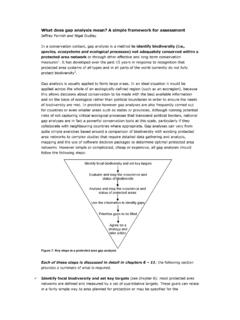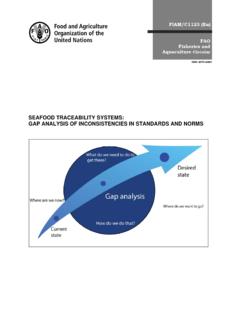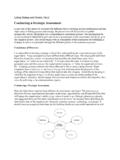Transcription of Human Factors & COMAH: A Gap Analysis Tool
1 Human Factors & COMAH A Gap Analysis Tool HSE/HID Onshore Human and Organisational Factors Team 1 of 5 Crown Copyright 2010 Introduction Within Europe, the Seveso II directive is concerned with the prevention of major accidents which might result from certain industrial activities and with the limitation of their consequences for man and the environment. It is implemented within each EC member state through local regulation. For the UK this is the Control of Major Accident Hazard Regulations 1999 (As Amended) (COMAH).
2 Both the directive and our regulations require sites which fall under the relevant definitions to demonstrate that they have taken all measures necessary to prevent and/or mitigate the consequences of major accidents. Where humans have a safety related role in this prevention and mitigation then all measures will include Human Factors . However, many operators find it difficult to link their major accident scenarios to the assured performance of safety related personnel. Human Factors are directly addressed in the COMAH regulations and accompanying guidance (L111).
3 A key feature of the regulations is the requirement for the highest risk category of major hazard sites, known as top tier sites, to produce a site safety report. This is essentially a thorough written risk assessment for the major accident hazards at the site. The Competent Authority (CA), which in the UK comprises the Health and Safety Executive (HSE) and the Environment Agency (EA), have a legal duty to provide feedback to the site on the content of their safety report. HSE have published guidance on how they will assess COMAH safety reports in the form of the Safety Report Assessment Manual (SRAM) ( ).
4 The SRAM contains technical assessment criteria for Human Factors . One of the fundamental criteria states that The safety report should demonstrate how the measures taken will prevent foreseeable failures which could lead to major accidents. For Human Factors this would be achieved by providing evidence in the safety report which demonstrates a practical approach for linking the major accident hazards (MAH) to the assured performance of humans engaged on the safety related tasks associated with those hazards. Human Factors Inspectors Toolkit As with any written risk assessment, the safety report only describes the hazards and their associated controls which when implemented will control the risks to an acceptable level.
5 The CA also has a legal duty to inspect top tier sites to confirm that the measures described in the safety report are actually implemented on site. In order to assist non specialist HSE inspectors in assessing the potential for Human Factors issues at COMAH sites, the HSE Onshore Human and Organisational Factors Team undertook a two year project to develop the Human Factors Inspectors Toolkit. Although initially intended for internal use, the toolkit is now available to anyone via the HSE web site ( ). The toolkit covers 11 topics under three categories and also includes a general description of the HSE approach to Human Factors .
6 The categories and topics are: 2 of 5 Crown Copyright 2010 Core Topics o Competence assurance o Human Factors in accident investigation o Identifying Human failure o Reliability and usability of procedures Common Topics o Emergency response o Maintenance error o Safety critical communications o Safety culture Specific Topics o Alarm handling and control room design o Managing fatigue risks o Organisational change and
7 Transition management Each topic entry contains a basic introduction to the Human Factors issues, the type of evidence the site should be able to provide and a list of questions which can be used to inspect the topic. Not only have HSE inspectors found the question sets a useful resource for establishing what evidence there is that the site is implementing Human Factors control measures, a limited number of sites have used this approach for themselves to identify where they may need to do more work to embed Human Factors in their overall safety management system (SMS).
8 This additional work can be collated into a timed action plan and added to the overall site improvement plan. A Human Factors Roadmap for the Management of Major Accident Hazards The aim of the Human Factors roadmap is to provide a structured framework by which the control of major accidents on a particular site can be linked to the assured performance of humans engaged on safety critical tasks which may initiate, or fail to mitigate, the major accident. This is achieved through the implementation of the Human Factors tools and management systems which are described in the Human Factors inspectors toolkit and associated HSE guidance HSG65, HSG48.
9 Whilst duty holders should adopt a hierarchical approach to the control of Human failures it is recognised that not all potential for Human failure can be designed out through engineering or instrumentation solutions. There will always be some residual risks which will need to be controlled by a procedural approach ensuring the safety management system provides an adequate level of support for the humans in the system. The roadmap framework deals with both these approaches, recognising that the engineering/automation 3 of 5 Crown Copyright 2010 route does not completely remove the potential for Human failure but moves it into the inspection, testing and maintenance activities which ensure the reliable performance of safety critical equipment.
10 A more detailed description of how the roadmap framework is applied, with links to topics in the toolkit, is given in the Human Factors roadmap documentation available via the HSE web site ( ). COMAH sites can apply the roadmap framework to the list of major hazard scenarios described in their COMAH safety report. This should provide evidence to demonstrate that the Human Factors elements of the site SMS have been effectively applied to the site major hazard scenarios and demonstrate that appropriate controls are in place to manage the performance of humans engaged on safety critical tasks.

















